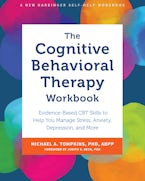By Michael A. Tompkins, PhD, ABPP, author of The Cognitive Behavioral Therapy Workbook
Have you ever wondered why one person gets very angry when cut off in traffic whereas another person feels mildly frustrated? Or why one person is terrified when giving a presentation to coworkers whereas another person is cool and calm? Well, it usually comes down to the different ways the two people think about the situation. Believe it or not, you have a great deal of control over how you think.
Thinking skills are a set of cognitive strategies that help you identify, evaluate, and respond to the way you think about the events and people in your life. For example, you’ll learn to put a thought on trial, a skill that you can apply to most thoughts regardless of the emotion or problem. Similarly, you’ll learn to identify thinking errors and test thoughts with experiments.
These skills are inside skills because they target the thoughts that influence your feelings and actions.
Why Are Thinking Skills Important?
Cognitive behavior therapy assumes that intense negative emotions, such as anxiety, depression, and anger, are maintained through unhelpful and often illogical thinking processes (Beck 1970; 1976; Beck, Emery, and Greenberg 1985; Beck, Rush, Shaw, and Emery 1979). Learning skills to evaluate and respond to unhelpful thinking helps in two ways:
· Thinking skills dim intense feelings: Feelings or emotions are completely normal and helpful. Even intense emotions on occasion are normal and helpful as long as they’re not so intense and so enduring that they make your life more difficult. If you’ve ever experienced a panic attack, you know what an intense feeling is like. Similarly, if you struggle with depression, you experience intense feelings of sadness that persist over time. Learning skills to think differently can decrease the intensity and duration of negative feelings so that you feel better in the moment and throughout the day.
· Thinking skills increase willingness: As you learn to dampen intense feelings by thinking about your thinking, you may be more willing to change your actions too. Most people with intense and persistent negative feelings tend to avoid these feelings and the situations that trigger them. It’s avoiding feelings rather than the feelings themselves that disrupts life. For example, if you feel intensely and persistently anxious because you worry excessively about what people think of you, then you might avoid the anxiety by declining to attend social events or give important presentations. Avoiding your anxiety in these situations can disrupt your personal and professional lives. Thinking skills that dampen the intensity of negative feelings will increase your willingness to face uncomfortable feelings, and thereby engage in life and prosper.
How to Think About Your Thinking
The process of thinking about your thinking involves three steps:
1. Identify: Learning to think about your thinking depends on your ability to identify the particular negative thoughts and unhelpful thought patterns that maintain the negative emotions that create problems in your life.
2. Evaluate: Learning to think about your thinking involves evaluating the helpfulness and reasonableness of a thought or thought pattern. Problematic feelings and actions rest on habitual and inflexible patterns of negative thinking.
3. Respond: The process of thinking about your thinking concludes with responding to the negative automatic thought with a reasonable, helpful, and accurate view of the situation. Typically, this is an alternative statement that you use to repeatedly respond to problematic automatic thoughts as they arise in the moment. By repeatedly responding to negative automatic thoughts with reasonable (coping) statements, you dim or interrupt the escalation of negative feelings.
Identify Automatic Thoughts
You can learn the best thinking skills in the world, but they’re useless if you don’t know the thoughts on which to focus the skills. Most people are very aware of the physical experience of a feeling, such as a racing heart when you’re feeling anxious, or fatigued, and slowed when you’re feeling depressed. However, many people are completely unaware of what they’re thinking when they’re feeling negative feelings, such as anxiety, depression, anger, or guilt. With a bit of practice, you can improve your awareness of these thoughts and their relationships to how you feel and act.
Michael A. Tompkins, PhD, ABPP, is a board-certified psychologist in behavioral and cognitive psychology. He is codirector of the San Francisco Bay Area Center for Cognitive Therapy, and a faculty member of the Beck Institute for Cognitive Behavior Therapy.



 Part 2: What to Do When a Client Is Participating in Self-Judgment?
Part 2: What to Do When a Client Is Participating in Self-Judgment?